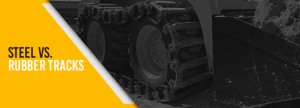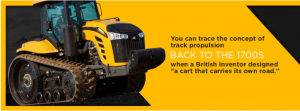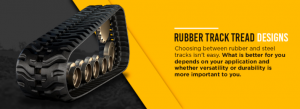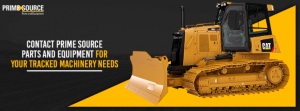
If you’re a tracked equipment owner or operator, there’s no doubt you’ve found yourself deciding between rubber and steel tracks. You might have run both track types on your machinery, but you’re still not sure what is better.
The answer depends on your application of the equipment. It also depends on the conditions in which you’re operating your tracked compact loader, excavator or multi-terrain loader. The best way to look at the question of rubber tracks vs. steel tracks is that rubber gives you more versatility while steel offers better durability.
Steel tracks have been around far longer than rubber tracks. Steel is still the track-of-choice for many excavator and loader owners. That’s because steel tracks are a proven commodity, while rubber track technology continues to evolve. Before looking at the advantages and disadvantages of steel and rubber tracks, let’s go back in time and learn how rubber and steel tracks have evolved.
How Steel and Rubber Tracks Evolved
Continuous tracks are part of a machine’s propulsion system. You’re familiar with modern track-equipped equipment like the many excavator forms operating across America’s job sites. You’ve also seen countless compact loaders scurrying about on revolving tracks. But, have you ever stopped to wonder how all these tracked wonders came to be?
You can trace the concept of track propulsion back to the 1700s when a British inventor designed “a cart that carries its own road.” In the 1830s, a Polish engineer furthered the idea but couldn’t raise the money to get something built. Funds also hampered a Russian Army Captain trying to invent a “carriage with mobile tracks.” The same underfunding problem befell another British entrepreneur who proposed a continuous track idea, which he dubbed the “universal railway.”

Continuous track success struck in the early twentieth century. Richard Hornsby and Sons, a British agricultural equipment manufacturer, made a tractor with continuous tracks that they called the “Hornsby Crawler.” An American soldier, who watched Hornsby’s test demonstrations and thought the machine crawled like a caterpillar, brought the idea home and presented it to Benjamin Holt of Holt Manufacturing.
Holt liked the continuous track concept and began working to improve the design. In 1925, Holt Manufacturing merged with the C.L. Best Tractor Co., and the Caterpillar Tractor Company was born. Today, we know it as Caterpillar®.
Caterpillar made all their early continuous tracks from steel. They might have thought of rubber tracks in the early days, but the technology and material supplies weren’t available. That changed in World War II when the Japanese military had limited steel access but plenty of rubber. They began equipping military vehicles with rubber tracks.
In peacetime America, rubber tracks quickly caught on. Steel tracks are still popular, but rubber offers some distinct advantages over it. Rubber tracks also have their disadvantages. Again, rubber tracks offer flexibility while steel guarantees strength. Both track types, however, can be far superior to tires in many conditions.
Why Choose Steel or Rubber Tracks Over Tires?
The main reason to choose tracks over tires has to do with weight distribution. Machines with tracks distribute their weight far more evenly across a greater surface area than equipment operating on tires. It’s all about an engineering or physics principle called “point loading.”
Tire-equipped machines displace their weight over a very small point where they transfer their live and dead loads to the ground. Tracked machines have a much greater surface contact area than tires, which significantly reduces their ground pressure or pounds-per-square-inch (PSI) point load factor. Simply put, tracks tend to float where tires sink.
The other big difference between machines with continuous tracks and equipment run on tires is speed. Wheels move faster than tracks. That’s fine if speed is your primary goal, but on a worksite, it’s often not.
Assuming you’ve discounted tires as a suitable option, you’re left with a choice — steel tracks vs. rubber tracks. To help you make that choice, let’s examine the difference between steel and rubber tracks.
The Difference Between Steel and Rubber Tracks
There’s more to the difference between rubber and steel tracks than their outward appearance. Yes, one track form has rubber-based construction, and the other is made with steel. But, it’s each form’s physical properties that give them an advantage or disadvantage over their crawling competitor.
Steel is a tough and durable material. It’s also heavy. That makes steel ideal for equipment that needs its track system to act as a counterweight and deliver a low center of gravity while working on harsh ground conditions.
Almost all steel used in today’s track manufacturing is recycled. But where steel excels as a track material is its linking ability. Steel tracks are a continuous chain of separate links that work together as a traction and weight distribution system.
Rubber tracks are also a continuous traction and weight transfer system. However, they are not separate links and have an Achilles Heel. If a steel link breaks, it can easily be removed and replaced. If a rubber track snaps, the whole assembly is ruined.
Rubber Track Tread Designs
Despite their risk of breaking, rubber tracks give you better cleat, tread or lug options that let you fine-tune your machine to specific ground conditions. Most steel tracks give you one cleat option. That’s the standard crossbar design. Rubber tracks give you these four tread design choices:
- Straight bar tread: This is the most common rubber track tread design on the market. It’s the same principle used on steel tracks, and it works well for most applications.
- Multi-bar tread: If you want a smoother ride and better access to multiple terrains, you’ll want to look into this tread. It’s an ideal design for snow and ice conditions.
- Staggered block tread: For improved traction and reduced impact on surfaces, the staggered block pattern is a smart choice.
- C-lug tread: You can recognize a C-lug due to the C-configuration notched into the tread block. C-lugs give advanced traction and turning capability under almost every surface condition.
Choosing between rubber and steel tracks isn’t easy. What is better for you depends on your application and whether versatility or durability is more important to you. Let’s drill down to the pros and cons when the steel or rubber hits the road.
Steel Track Advantages
There’s an excellent reason why steel tracks still dominate the machinery industry. It’s durability. Steel is superior to rubber when it comes to taking a beating and continuing to crawl. You can find steel tracks turning in every temperature from frigid cold to scalding hot. Steel tracks scrape across rock and demolition debris that would eliminate their elastic equivalent.
Steel tracks have enormous advantages in certain conditions. But, whether you need steel depends on the conditions you plan on operating in. It also depends on factors like purchase cost, maintenance requirements, counterweight requirements and noise. Here are the main advantages you’ll get with steel tracks on your machines:
- Wear and durability: Being tough and durable is the chief advantage you’ll get with a set of steel tracks. Steel has an exceptional durability factor that significantly outlasts even the best-made rubber counterparts.
- Counterweight and balance: The weight of steel tracks can be a significant advantage to machines like heavy excavators that move mounds of material high above their center of gravity. Steel tracks’ weight lowers the center of gravity or tipping point and helps to stabilize the machine.
- Traction and load transfer: Steel tracks have an even weight transfer pattern that reduces point loading on all types of terrain and working surfaces. Steel gives a much more uniform load distribution, unlike rubber, which tends to flex and increase point loading.
- Repair and maintenance: Because steel is strong and wear-resistant, you’ll have fewer repairs and maintenance on tracks constructed from steel links. Less maintenance and repair means less downtime and more profitability in your work contracts.
- Cleaning and upkeep: Steel tracks are easy to clean. Some operators refer to steel tracks as self-cleaning. Upkeep is low with steel-tracked equipment, and that means you can get more work done.
Steel Track Disadvantages
Although steel-tracked equipment has many advantages, you do have to consider the downsides to moving on metal. It’s not that any disadvantages outweigh the benefits, but you should be aware of the drawbacks. Here are the main disadvantages of going the steel track route:
- Equipment cost: Steel tracks and their specially designed undercarriages are expensive. It’s estimated that 20 percent of a machine’s purchase price and 50 percent of its maintenance expenses go into steel tracks and the supporting undercarriage.
- Surface damage: There’s no argument here. Steel tracks are far more aggressive on the ground and do more surface damage than rubber tracks. If you’re working in sensitive conditions, then steel tracks aren’t your best choice.
- Machine weight: This can be a pro or a con. Steel tracks weigh a lot more than rubber. On the one hand, weight works well to counterbalance loads. On the other, heavy tracks add to surface pressure and transportation issues.
- Noise factor: Steel tracks make a great deal of racket. You can hear a steel-tracked machine working from a long way off. If you’re in town or a noise-sensitive situation, then steel tracks will be a disadvantage.
- Operator comfort: There’s not much give or flexibility with steel tracks. They don’t absorb shock and vibration, which sends waves back through the machine and into your operator. This may contribute to long-term back, shoulder, arm and hand issues.
Rubber Track Advantages
Rubber tracks have made their mark on the continuous track equipment industry. In the past several decades, more and more rubber-tracked machines are unloaded and put to work on American job sites. While they haven’t replaced the steel track lead, these flexible treads have certainly had their impact.
There are certainly areas where rubber tracks have their advantages. The most significant benefit of rubber tracks is their versatility. They’re capable of performing on many surfaces where steel tracked machines would fear to tread. Here are the other main advantages of equipping your machinery with tracks made from rubber:
- Affordability: It’ll cost you less money initially to buy rubber tracks than steel tracks. However, rubber might not last as long as steel.
- Comfort: Vibrations and shock transfer are much lower with rubber tracks, which significantly improves operator comfort.
- Impact: If you expect to operate your machine on surfaces you don’t want to damage, go for rubber tracks every time. They have far less impact than steel cleats.
- Speed: Rubber-tracked machines move faster than those with steel rotating over their undercarriage. Where speed and mobility are required, you’d be smart to outfit your equipment with rubber.
- Maneuverability: Steel tracks aren’t known for having great maneuverability, as they chew up things when they turn too fast. This isn’t the case with rubber tracks, which makes them advantageous in situations that require high maneuverability.
Rubber Track Disadvantages
Where there are good things to be said, you’ll usually find an opposing negative. That’s the case with rubber tracks, and there are some downsides to rubberizing your machine. These are the main disadvantages you’ll find with rubber tracks:
- Durability: Rubber tracks won’t take the abuse that steel puts up with. On harsh surfaces like jagged rock and demolition debris, rubber tracks get shredded in no time.
- Traction: On many types of surfaces, rubber tracks don’t get the same traction you’d get with steel. Steel’s weight and load distribution are superior to rubber in mud, sand, ice and snow.
- Temperature: This is a big issue in many areas where you’d operate a machine with rubber tracks. Rubber can become brittle in the cold and malleable in the heat.
- Repairing: Rubber tracks aren’t easy to repair. You can’t simply replace a link like you can with steel tracks.
What Should You Choose—Steel or Rubber Tracks?
That’s a wrap on the rubber vs. steel track debate. You now have information to support your decision, but the choice of rubber or steel tracks is up to you.
In large part, the right choice for you depends on your application. If you want versatility, then rubber is the best choice. If you’re looking for durability, then you’re better off operating on steel. There’s one choice, though, that’s not hard to make. That’s to contact Prime Source Parts and Equipment for all your tracked machinery and undercarriage needs.
Contact Prime Source Parts and Equipment for Your Tracked Machinery Needs
At Prime Source Parts and Equipment, we say, “If it crawls, give us a call.” Prime Source is North Carolina’s leading source of product support solutions for all machinery makes and models, including Cat, John Deere, Hitachi, Komatsu, Link Belt and more. To find out more about Prime Source services, give us a call today at 704-597-0030. Or request a quote through our online contact form.




